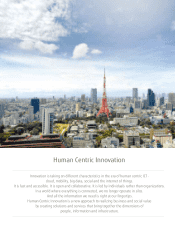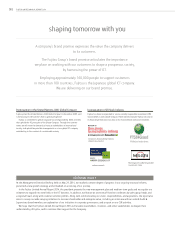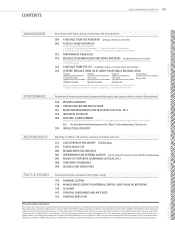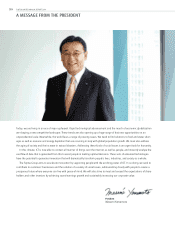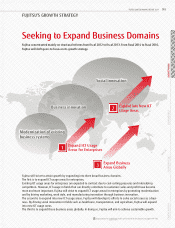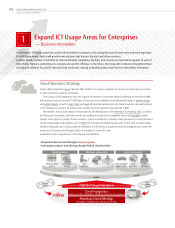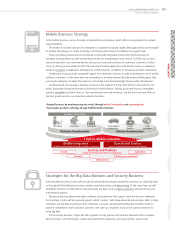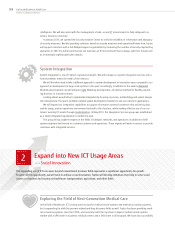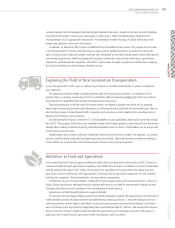Fujitsu 2014 Annual Report Download - page 12
Download and view the complete annual report
Please find page 12 of the 2014 Fujitsu annual report below. You can navigate through the pages in the report by either clicking on the pages listed below, or by using the keyword search tool below to find specific information within the annual report.
3
Market Characteristics
• Promoting ODA* and government projects (special economic zones, smart
city projects, accelerated building of social infrastructure)
• Expanding markets for made-in-Japan solutions (medical care, transporta-
tion, financial services)
• Developing business in Myanmar (opening of office in Yangon)
• Using ICT to support Japanese companies’ accelerating expansion in the region
Fujitsu’s Initiatives
Standing on the threshold of the cloud computing era, our customers’ needs for global ICT services are increasing
at an ever faster pace. That is why strengthening the overseas business structure has become a key priority for
Fujitsu. We established a global matrix structure in 2012 and have been pushing ahead with globalizing our
operations. Until now, we had a separate organization in place to manage our international operations. In April
2014, however, we abolished the “International” category and reorganized our global operations into five
regions. Under this new organizational structure, we will work to further increase collaboration on a global scale,
including Japan.
Additionally, we established the Global Delivery group. Specifically, we will promote the global provision of
uniform services centered on managed services and innovation solutions.
To strengthen global delivery capabilities, we will establish and expand global services locations. We will also
establish globally standardized tools and platforms for providing services.
To achieve these priorities, we are initiating development investments, training and infrastructure develop-
ment, and examining M&As.
As an example of how we are developing managed services, we helped a financial services organization
outside Japan switch 50,000 PCs to thin client terminals. Through managed services in 20 countries around the
world, including consulting on deployment, we are helping to enhance the global competitiveness of this customer.
Business deals like these are increasing rapidly in number. By reinforcing our global delivery structure, we are
preparing to steadily meet this growing demand.
We will be focusing on the ASEAN region as a prom-
ising growth market.
We expect the ASEAN region to continue further
economic development following the inception of the
ASEAN Economic Community in 2015, in addition to
the economic growth of the individual ASEAN coun-
tries. Working closely with governments and related
organizations, Fujitsu will contribute to the develop-
ment of social infrastructure in each country based on
solutions that have a proven track record in Japan.
Fujitsu opened an office in Myanmar. We are using
ICT to support Japanese companies’ accelerating
expansion in the ASEAN region, and are also stepping
up efforts to expand markets for made-in-Japan solu-
tions in the region.
Starting in fiscal 2014, Fujitsu is voluntarily adopting IFRS for its consolidated financial statements. Outside of Japan, the Fujitsu Group has
expanded its business across the globe, to regions such as Europe, the Americas, and Asia. As the importance of its business outside of Japan
grows year by year, IFRS, a single, uniform accounting standard for Group companies, including those based outside of Japan, will enable coherent
business management in and outside of Japan. Moreover, by implementing IFRS-based business management as the management platform for
Fujitsu as a truly global company, the Company will pursue greater efficiency to promote global growth and to increase its corporate value. In
adopting IFRS, Fujitsu also seeks to facilitate international comparisons of financial information in global capital markets.
The figures in the medium-term management plan on the following page are calculated in accordance with IFRS.
Expand Business Areas Globally
•
Fujitsu’s initiatives in ASEAN, a region on its way toward
a new stage of growth
• Growth in the greater Mekong and Malay economic region
• Development of East-West corridor linking economies around the Indian Ocean
(including Myanmar)
• Growing presence of Japanese corporations in ASEAN
• ASEAN Economic Community to launch in 2015
Voluntary Adoption of IFRS
* ODA: Official Development Assistance
010 FUJITSU LIMITED ANNUAL REPORT 2014
FUJITSU’S GROWTH STRATEGY



